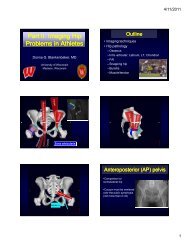Ankle and Foot 47 - Department of Radiology - University of ...
Ankle and Foot 47 - Department of Radiology - University of ...
Ankle and Foot 47 - Department of Radiology - University of ...
You also want an ePaper? Increase the reach of your titles
YUMPU automatically turns print PDFs into web optimized ePapers that Google loves.
<strong>47</strong> <strong>Ankle</strong> <strong>and</strong> <strong>Foot</strong> 2245 <strong>47</strong><br />
A<br />
Figure <strong>47</strong>-50. A knee coil can be used to scan the ankle. A, The open top on this knee coil allows the toes to extend through the coil while<br />
keeping the foot in neutral position. B, A customized foam pad (white arrow) helps immobilize the hindfoot being scanned. A second pad next to<br />
the coil (black arrow) give the contralateral foot a place to rest.<br />
B<br />
A<br />
B<br />
C<br />
D<br />
Figure <strong>47</strong>-51. Example <strong>of</strong> a patient who could not be positioned in the foot or knee coil. This is a 41-year-old with paraplegia from spina bifida<br />
who is essentially frozen in the fetal position. The clinical concern was for infection in <strong>and</strong> around the ankle joint. Because the patient was<br />
physically unable to straighten her legs, we could not use the foot coil. Instead, we used a torso coil <strong>and</strong> covered the leg <strong>and</strong> ankle. A, Lateral<br />
radiograph shows s<strong>of</strong>t tissue swelling. B, T1-weighted, large field-<strong>of</strong>-view image covering the entire leg as well as the ankle. Because <strong>of</strong> difficulty<br />
positioning the patient, a portion <strong>of</strong> the other leg is also within the coil. C, Inversion recovery image shows no bone marrow edema but diffuse<br />
edema <strong>of</strong> the subcutaneous fat. D, T1-weighted image with fat suppression after the administration <strong>of</strong> intravenous gadolinium shows diffuse<br />
enhancement <strong>of</strong> the subcutaneous fat, indicative <strong>of</strong> cellulitis. The lack <strong>of</strong> enhancement <strong>and</strong> edema in the bone marrow exclude osteomyelitis. The<br />
gray arrow points to inadequate fat suppression at the edge <strong>of</strong> the coil, a common occurrence with large fields <strong>of</strong> view.<br />
The straight sagittal plane (see Fig. <strong>47</strong>-52A) is our survey<br />
plane, <strong>and</strong> it is usually the first plane acquired in all <strong>of</strong> our<br />
ankle <strong>and</strong> foot MRI protocols. Most <strong>of</strong> the other imaging<br />
planes are acquired relative to a straight sagittal reference<br />
image. The straight sagittal slices are set up <strong>of</strong>f an axial scout<br />
image <strong>and</strong> are oriented parallel to the long axis <strong>of</strong> the foot.<br />
At least two axial orientations are typically used.<br />
Straight axial slices (see Fig. <strong>47</strong>-52B) are set up <strong>of</strong>f a straight<br />
sagittal reference image, either a sagittal scout image or<br />
one <strong>of</strong> the midsagittal slices from the preceding acquisition.<br />
The straight axial slices should be roughly perpendicular<br />
to the long axis <strong>of</strong> the tibia <strong>and</strong> if the ankle is<br />
held in the neutral position will be roughly parallel to<br />
the bottom <strong>of</strong> the foot. The slices should begin well proximal<br />
to the level <strong>of</strong> the malleoli <strong>and</strong> extend distal to<br />
the calcaneus. This is our primary plane for imaging the<br />
Ch0<strong>47</strong>-A05375.indd 2245<br />
9/9/2008 5:34:31 PM
















